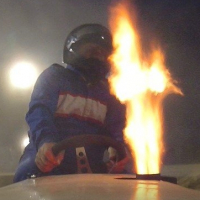Small Engine Dyno's
 Brian_B
Posts: 842
Brian_B
Posts: 842
Hi,
does anybody have any any photos of a small engine dyno or know anybody using one ?
▔▔▔▔▔▔▔▔▔▔▔▔▔▔▔▔▔▔▔▔▔▔▔▔
Thank's Brian
www.truckwiz.com
·"Imagination is more important than knowledge..." ·· Albert Einstein
does anybody have any any photos of a small engine dyno or know anybody using one ?
▔▔▔▔▔▔▔▔▔▔▔▔▔▔▔▔▔▔▔▔▔▔▔▔
Thank's Brian
www.truckwiz.com
·"Imagination is more important than knowledge..." ·· Albert Einstein


Comments
It's pretty simple to make one (I plan to at some point). Two bearings, an axle, and a big mass to rotate. Add a Propeller and some sort of measurement device to measure RPM, a bit of calibration, and you can pretty easily get to within an HP of accuracy. It won't have a brake, but it will be a good start.
-Parsko
▔▔▔▔▔▔▔▔▔▔▔▔▔▔▔▔▔▔▔▔▔▔▔▔
Thank's Brian
www.truckwiz.com
·"Imagination is more important than knowledge..." ·· Albert Einstein
http://en.wikipedia.org/wiki/Dyno
By far the most important parameter is the Moment of Inertia of the spinning mass. A 5lb mass could be used to measure 5000HP, but the 5lb's of mass would have to be placed on a HUGE diameter.
Also, do you want a chassis dyno, or engine? If you're talking about a chassis dyno, for cars, don't waste your time, and simply buy a used Dynojet for $5k. If we're talking about motorcycles (like my desire), then I would say go for it. Once you know all the parameters (like inertia and mass), it is pretty easy to determine the HP on the fly be measuring the change in acceleration.
-Parsko
http://www1.cedar-rapids.net/tdkmotor/DYNO.HTM
▔▔▔▔▔▔▔▔▔▔▔▔▔▔▔▔▔▔▔▔▔▔▔▔
Thank's Brian
www.truckwiz.com
·"Imagination is more important than knowledge..." ·· Albert Einstein
I agree with the technique these guys went through to get a working dyno, but I think you're gonna be able to do them better. Your handful of props are why. I would dedicate one to the dyno. One will easily be enough.
I would personally incorporate two clutches, to minimize friction in the system. I'd use 1 for the drive side, and one for the brake side. Or, you could set it up so that once the run is done, the clutch automatically disengages and the brake engages. There are all sorts of clever things that can be done of you're not headed for production...
Also, with a prop, you could get more precision than these guys are, I would guess. If you incorporate your 25lb flywheel, all you would need is a hall sensor to look at the starter teeth, and you'll have a wickedly accurate system, of which the prop could easily capture. If there are 100 teeth, running at 2000rpm, you're gonna have 3333Hz output from the hall sensor, again, well within the range of the prop, especially with a 32bit counter monitoring it in assembly. This will also make your initial calibration more accurate.
Okay, enough from me, back to work, I could continue to ramble on without making much sense all day long!!!
-Parsko